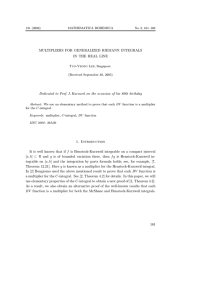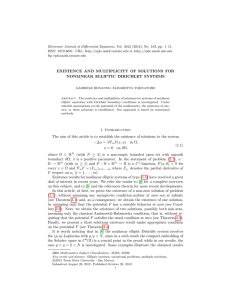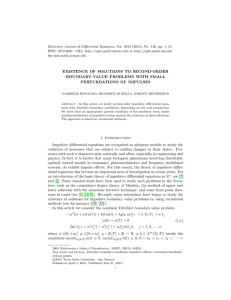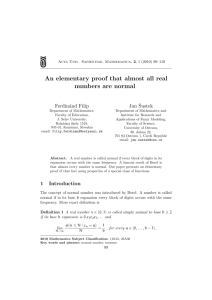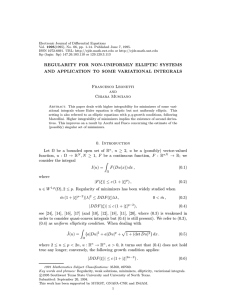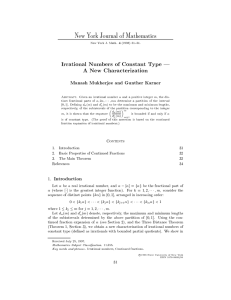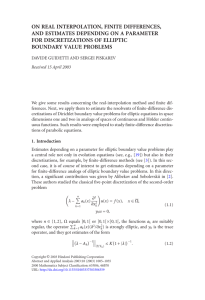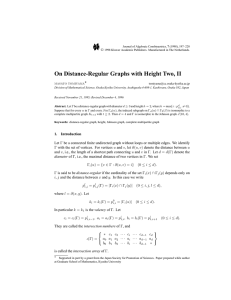Electronic Journal of Differential Equations, Vol. 2015 (2015), No. 257,... ISSN: 1072-6691. URL: or
advertisement
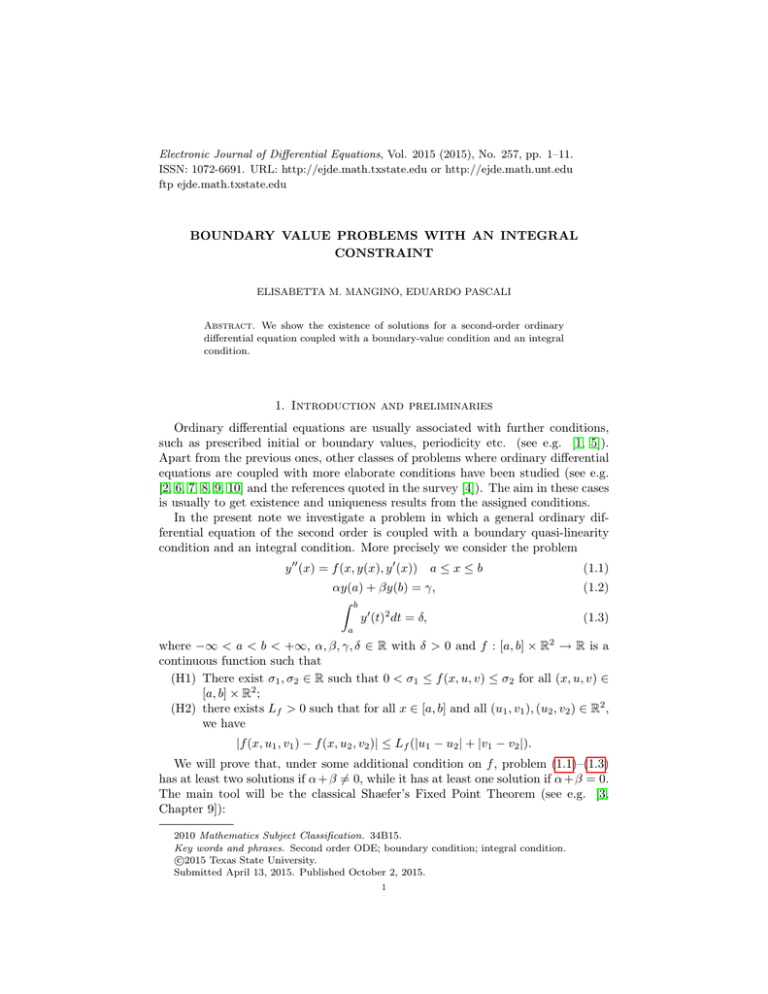
Electronic Journal of Differential Equations, Vol. 2015 (2015), No. 257, pp. 1–11.
ISSN: 1072-6691. URL: http://ejde.math.txstate.edu or http://ejde.math.unt.edu
ftp ejde.math.txstate.edu
BOUNDARY VALUE PROBLEMS WITH AN INTEGRAL
CONSTRAINT
ELISABETTA M. MANGINO, EDUARDO PASCALI
Abstract. We show the existence of solutions for a second-order ordinary
differential equation coupled with a boundary-value condition and an integral
condition.
1. Introduction and preliminaries
Ordinary differential equations are usually associated with further conditions,
such as prescribed initial or boundary values, periodicity etc. (see e.g. [1, 5]).
Apart from the previous ones, other classes of problems where ordinary differential
equations are coupled with more elaborate conditions have been studied (see e.g.
[2, 6, 7, 8, 9, 10] and the references quoted in the survey [4]). The aim in these cases
is usually to get existence and uniqueness results from the assigned conditions.
In the present note we investigate a problem in which a general ordinary differential equation of the second order is coupled with a boundary quasi-linearity
condition and an integral condition. More precisely we consider the problem
y 00 (x) = f (x, y(x), y 0 (x)) a ≤ x ≤ b
(1.1)
αy(a) + βy(b) = γ,
Z b
y 0 (t)2 dt = δ,
(1.2)
(1.3)
a
where −∞ < a < b < +∞, α, β, γ, δ ∈ R with δ > 0 and f : [a, b] × R2 → R is a
continuous function such that
(H1) There exist σ1 , σ2 ∈ R such that 0 < σ1 ≤ f (x, u, v) ≤ σ2 for all (x, u, v) ∈
[a, b] × R2 ;
(H2) there exists Lf > 0 such that for all x ∈ [a, b] and all (u1 , v1 ), (u2 , v2 ) ∈ R2 ,
we have
|f (x, u1 , v1 ) − f (x, u2 , v2 )| ≤ Lf (|u1 − u2 | + |v1 − v2 |).
We will prove that, under some additional condition on f , problem (1.1)–(1.3)
has at least two solutions if α + β 6= 0, while it has at least one solution if α + β = 0.
The main tool will be the classical Shaefer’s Fixed Point Theorem (see e.g. [3,
Chapter 9]):
2010 Mathematics Subject Classification. 34B15.
Key words and phrases. Second order ODE; boundary condition; integral condition.
c
2015
Texas State University.
Submitted April 13, 2015. Published October 2, 2015.
1
2
E. M. MANGINO, E. PASCALI
EJDE-2015/257
Theorem 1.1 (Schaefer’s theorem). Let T be a continuous and compact mapping
of a Banach space X into itself, such that the set
{x ∈ X : x = λT x for some 0 ≤ λ ≤ 1}
is bounded. Then T has a fixed point.
We start with some preliminary observations.
Lemma 1.2. If y ∈ C 2 [a, b] satisfies (1.1) and (1.3), then
i2
hZ bZ t
f (t, y(s), y 0 (s))dsdt
∆(y) :=
a
a
b
hZ
− (b − a)
a
and either for every x ∈ [a, b],
RbRt
a
a
t
hZ
i2
i
f (t, y(s), y (s))ds dt − δ ≥ 0
a
f (s, y(t), y 0 (s)) ds dt +
b−a
p
f (s, y(s), y 0 (s)) ds dt −
b−a
p
y(x) = y(a) −
Z xZ t
+
f (s, y(s), y 0 (s)) ds dt ,
a
(1.4)
0
∆(y)
(x − a)
a
or for every x ∈ [a, b],
RbRt
a
a
y(x) = y(a) −
Z xZ t
+
f (s, y(s), y 0 (s)) ds dt .
a
∆(y)
(x − a)
a
Proof. By integrating (1.1), we obtain
Z x
hZ
y 0 (x)2 = y 0 (a)2 + 2y 0 (a)
f (t, y(t), y 0 (t))dt +
a
x
i2
f (t, y(t), y 0 (t))dt .
a
Hence, by (1.3), y 0 (a) is a solution of the equation
Z bZ t
2
z (b − a) + 2z
f (s, y(s), y 0 (s)) ds dt
a
b
Z
+
hZ
a
t
a
i2
f (s, y(s), y (s))ds dt − δ = 0.
(1.5)
0
a
Therefore,
∆(y) :=
b
hZ
t
Z
a
i2
f (s, y(s), y 0 (s))dsdt
a
− (b − a)
hZ
b
a
and
hZ
t
i2
i
f (s, y(s), y 0 (s))ds dt − δ ≥ 0
a
RbRt
p
f (s, y(s), y 0 (s)) ds dt ± ∆(y)
y (a) =
.
(1.6)
b−a
We obtain the assertion by observing that, if y ∈ C 2 [a, b] is a solution of (1.1), then
Z xZ t
0
y(x) = y(a) + y (a)(x − a) +
f (s, y(s), y 0 (s)) ds dt.
(1.7)
0
−
a
a
a
a
EJDE-2015/257
BVPS WITH AN INTEGRAL CONSTRAINT
3
2. The case α + β = 0
If α + β = 0, α 6= 0 and y ∈ C 2 [a, b] is a solution of (1.1)–(1.3), then by (1.7),
Z bZ t
0
y(b) = y(a) + y (a)(b − a) +
f (s, y(s), y 0 (s))ds
a
a
and therefore, by (1.2),
1
γ
y (a) = −
−
α(b − a) b − a
0
Z
b
t
Z
f (s, y(s), y 0 (s))ds.
(2.1)
a
a
But y 0 (a) solves (1.5), therefore comparing (1.6) and (2.1), we get that ∆(y) = γ = 0
and
Z bZ t
1
0
f (s, y(s), y 0 (s))ds.
y (a) = −
b−a a a
Thus problem (1.1)–(1.3) turns into
y 00 (x) = f (x, y(x), y 0 (x)),
a ≤ x ≤ b,
y(a) = y(b),
(2.3)
b
Z
y 0 (t)2 dt = δ.
(2.4)
a
Integrating by parts (2.4), we find that
Z b
δ=
y 0 (x)2 dx
a
= y(b)y 0 (b) − y(a)y 0 (a) −
b
Z
y(s)f (s, y(s), y 0 (s))ds
a
0
Z
0
= y(a)(y (b) − y (a)) −
b
y(s)f (s, y(s), y 0 (s)ds
a
b
Z
b
Z
0
= y(a) ·
y(s)f (s, y(s), y 0 (s))ds.
f (s, y(s), y (s))ds −
a
a
Hence
Z
b
y(a) ·
Z
0
f (s, y(s), y (s))ds = δ +
a
b
y(s)f (s, y(s), y 0 (s))ds
a
Assuming (H1), we obtain
Z b
f (s, y(s), y 0 (s))ds ≥ σ1 (b − a) > 0.
a
Therefore
y(a) =
δ+
Rb
a
Rb
a
y(s)f (s, y(s), y 0 (s))ds
f (s, y(s), y 0 (s))ds
and
y(x) =
δ+
Z
+
Rb
y(s)f (s, y(s), y 0 (s))ds
a
Rb
f (s, y(s), y 0 (s))ds
a
Z
x
t
0
x−a
−
b−a
f (s, y(s), y (s)) ds dt.
a
a
(2.2)
Z
a
b
Z
a
t
f (s, y(s), y 0 (s))ds
4
E. M. MANGINO, E. PASCALI
EJDE-2015/257
As a consequence, we easily obtain the following characterization of the solutions
of (2.2)–(2.4).
Lemma 2.1. Assume that (H1) holds. Then y ∈ C 2 [a, b] is a solution of (2.2)–
(2.4) if and only if y ∈ C 1 [a, b] and for every x ∈ [a, b]
Rb
Z Z
δ + a y(s)f (s, y(s), y 0 (s))ds x − a b t
f (s, y(s), y 0 (s))ds
y(x) =
−
Rb
0 (s))ds
b−a a a
f
(s,
y(s),
y
a
Z xZ t
f (s, y(s), y 0 (s)) ds dt.
+
a
a
We consider now the following assumptions:
(H1’) There exists σ3 > 0 such that |uf (x, u, v)| ≤ σ3 for all (x, u, v) ∈ [a, b] × R2 .
(H2)’ There exists L > 0 such that fore all x ∈ [a, b] and all (u1 , v1 ), (u2 , v2 ) ∈ R2 ,
|u1 f (x, u1 , v1 ) − u2 f (x, u2 , v2 )| ≤ L(|u1 − u2 | + |v1 − v2 |).
Theorem 2.2. If (H1), (H2), (H1’), (H2’) hold, then there exists at least one
solution of (2.2)–(2.4).
Proof. Consider the map T : C 1 [a, b] → C 1 [a, b] defined by
Rb
Z Z
δ + a y(s)f (s, y(s), y 0 (s))ds x − a b t
T y(x) =
+
f (s, y(s), y 0 (s))ds
Rb
0 (s))ds
b−a a a
f
(s,
y(s),
y
a
Z xZ t
+
f (s, y(s), y 0 (s)) ds dt.
a
a
By Lemma 2.1, a function y ∈ C 2 [a, b] is a solution of (2.2)–(2.4) if and only if
y ∈ C 1 [a, b] is a fixed point of T .
Observe that for every y ∈ C 1 [a, b] and every x ∈ [a, b]:
Z bZ t
Z x
1
f (s, y(s), y 0 (s))ds +
f (s, y(s), y 0 (s))ds
(T y)0 (x) =
b−a a a
a
(T y)00 (x) = f (x, y(x), y 0 (x)),
hence for every x ∈ [a, b],
δ + σ3 (b − a)
+ σ2 (b − a)2
σ1 (b − a)
3
|(T y)0 (x)| ≤ (b − a)σ2
2
|(T y)00 (x)| ≤ σ2 .
|T y(x)| ≤
(2.5)
(2.6)
(2.7)
Moreover, for every y, z ∈ C 1 [a, b], x ∈ [a, b]:
|T y(x) − T z(x)|
Z b
Z
≤ δ+
y(s)f (s, y(s), y 0 (s))ds
− δ+
a
Z b
Z
z(s)f (s, z(s), z 0 (s))ds
a
÷
Z
a
b
f (s, y(s), y 0 (s))ds
b
a
b
f (s, z(s), z 0 (s))ds
f (s, y(s), y 0 (s))ds
a
Z
a
b
f (s, z(s), z 0 (s))ds + Lf (b − a)2 ky − zkC 1
EJDE-2015/257
≤
BVPS WITH AN INTEGRAL CONSTRAINT
5
δLf
Lf σ3 + Lσ2
ky − zkC 1 +
ky − zkC 1 + Lf (b − a)2 ky − zkC 1
2
(b − a)σ1
σ12
and
|(T y)0 (x) − (T z)0 (x)| ≤
3
Lf (b − a) · ky − zkC 1 ,
2
hence
kT y − T zkC 1 ≤
h L σ + Lσ
3
i
δ
f 3
2
+ Lf (b − a) + (b − a)2 +
ky − zkC1 .
2
2
σ1
2
(b − a)σ1
Thus T is continuous on C 1 [a, b].
We prove that T is also compact. Let (yn ) be a sequence in C 1 [a, b]. Then
((T yn )0 )n is a bounded sequence of continuous functions such that ((T yn )00 )n is
also bounded. By Ascoli-Arzelà’s theorem there exists a subsequence (ykn )n such
that ((T ykn )0 )n is uniformly convergent on [a, b]. On the other hand, (T yn )n is a
bounded sequence in C 1 [a, b], hence, passing to a subsequence if necessary, we can
assume that (T ykn (a))n is convergent. It follows that (T ykn )n converges in C 1 [a, b].
Thus, observing that the set
{y ∈ C 1 [a, b] : y = λT y for some λ ∈ [0, 1]}
is clearly bounded by (2.5) and (2.6), by Schaefer’s theorem, T has a fixed point.
An immediate application of the Schauder’s Fixed Point Theorem gives the following result.
Corollary 2.3. If
3
Lf σ3 + Lσ2
δ
2
+
L
(b
−
a)
+
(b
−
a)
+
<, 1
f
σ12
2
(b − a)σ12
then problem (2.2)–(2.4) has a unique solution in C 2 [a, b].
3. The case α + β 6= 0
The main result of this section is the following Theorem.
Theorem 3.1. If α + β 6= 0, (H1) and (H2) hold and
(H3) (3σ12 − 4σ22 )(b − a)3 + 12δ > 0,
then there exist at least two solutions to (1.1)–(1.3).
We need first some lemmas about ∆(y), defined for every y ∈ C 1 [a, b] as in (1.4).
Lemma 3.2. If (H1), (H2) hold, then for every y ∈ C 1 [a, b],
(3σ12 − 4σ22 )(b − a)4 + 12δ(b − a)
12
(3σ22 − 4σ12 )(b − a)4 + 12δ(b − a)
≤ ∆(y) ≤ M2 :=
12
M1 :=
(3.1)
and for every y, z ∈ C 1 [a, b],
|∆(y) − ∆(z)| ≤
7
σ2 L(b − a)4 ky − zkC 1 .
6
(3.2)
6
E. M. MANGINO, E. PASCALI
EJDE-2015/257
Proof. By (H1), it holds that
Z b
hZ b
i2
∆(y) ≥ σ12
(t − a)dt + δ(b − a) − (b − a)σ22
(t − a)2 dt
a
a
(b − a)4
(b − a)4
= σ12
+ δ(b − a) − σ22
4
3
(3σ12 − 4σ22 )(b − a)4 + 12δ(b − a)
=
.
12
On the other hand,
∆(y) ≤ σ22
(3σ22 − 4σ12 )(b − a)4 + 12δ(b − a)
(b − a)4
(b − a)4
+ δ(b − a) − σ12
=
.
2
3
12
Moreover,
|∆(y) − ∆(z)|
h Z b Z t
i2 h Z
≤
f (s, y(s), y 0 (s))dsdt −
a
a
a
Z
+ (b − a)
a
Z
=
b
Z
a
Z
×
t
hZ
t
Z
a
t
i2 f (s, z(s), z 0 (s))dsdt Z
i2
f (s, z(s), z (s))ds dt −
a
0
b
hZ
a
t
a
i2 f (s, y(s), y 0 (s))ds dt
[f (s, y(s), y 0 (s)) − f (s, z(s), z 0 (s))] ds dt
a
bZ x
a
b
b
a
[f (s, y(s), y 0 (s)) + f (s, z(s), z 0 (s))] ds dt
Z bhZ t
i
+ (b − a)
[f (s, y(s), y 0 (s)) − f (s, z(s), z 0 (s))]ds
a
a
hZ t
i ×
[f (s, y(s), y 0 (s)) + f (s, z(s), z 0 (s))]ds dt
a
≤ σ2 Lf
=
2
(b − a)4
+ σ2 Lf (b − a)4 g ky − zkC 1
2
3
7
σ2 Lf (b − a)4 ky − zkC 1 .
6
As immediate consequence we have the lemma.
Lemma 3.3. Assume that (H1), (H2), (H3) hold, and for every y ∈ C 1 [a, b]
p
RbRx
− a a f (t, y(t), y 0 (t)) dt dx + ∆(y)
A1 (y) =
b−a
p
RbRx
− a a f (t, y(t), y 0 (t)) dt dx − ∆(y)
A2 (y) =
b−a
1
Then, for i = 1, 2, for every y, z ∈ C [a, b],
1 h (b − a)2 p i
|Ai (y)| ≤
σ2
+ M2
b−a
2
h1
i
7σ2
|Ai (y) − Ai (z)| ≤ Lf (b − a) + √
(b − a)2 ky − zkC 1 ,
2 12 M1
where M1 and M2 are defined in Lemma 3.2.
define
(3.3)
(3.4)
(3.5)
(3.6)
EJDE-2015/257
BVPS WITH AN INTEGRAL CONSTRAINT
7
Proof. First observe that A1 and A2 are well-defined on C 1 [a, b], since ∆(y) ≥ 0
for every y ∈ C 1 [a, b] by Lemma 3.2 and (H3). For every y ∈ C 1 [a, b] and i = 1, 2,
by (3.1), we have
Z Z
p
1 b t
f (s, y(s), y 0 (s)) ds dt + | ∆i (y)|
|Ai (y)| ≤
b−a
a
a
1 (b − a)2 p σ2
≤
+ M2 .
b−a
2
Moreover, by (3.2), for every y, z ∈ C 1 [a, b],
|Ai (y) − Ai (z)|
p
p
R R
− ab at [f (s, y(s), y 0 (s)) − f (s, z(s), z 0 (s))] ds dt ±
∆(y)
−
∆(z)
=
b−a
1 h
|∆(y) − ∆(z)| i
(b − a)2
p
≤
+ p
Lf ky − zkC 1
b−a
2
| ∆(y) + ∆(z)|
1 h
|∆(y) − ∆(z)| i
(b − a)2
√
≤
+
Lf ky − zkC 1
b−a
2
2 M1
i
7
1 h
(b − a)2
+ √
≤
Lf ky − zkC 1
σ2 Lf (b − a)4 ky − zkC 1 .
b−a
2
12 M1
Proof of Theorem 3.1. Observe first that if α + β 6= 0 and y ∈ C 2 [a, b] is a solution
of (1.1), (1.2), then
Z xZ t
y(x) = y 0 (a)(x − a) +
f (s, y(s), y 0 (s) ds dt
a
a
(3.7)
Z bZ t
i
1 h
0
0
γ − βy (a)(b − a) − β
f (s, y(s), y (s)) ds dt
+
α+β
a
a
By comparing (3.7) with (1.6) and by Lemma 3.3, we obtain that for i = 1 or
i = 2,
Z xZ t
y(x) = Ai (y)(x − a) +
f (s, y(s), y 0 (s) ds dt
a
a
(3.8)
Z bZ t
i
1 h
γ − βAi (y)(b − a) − β
f (s, y(s), y 0 (s)) ds dt
+
α+β
a
a
It is immediate to prove that, conversely, if y ∈ C 1 [a, b] satisfies (3.8), then y ∈
C 2 [a, b] and y is a solution of (1.1)–(1.3).
Thus y ∈ C 2 [a, b] is a solution of (1.1)–(1.3) if and only if y is a fixed point of
one of the operators Ti : C 1 [a, b] → C 1 [a, b], i = 1, 2 defined by
Z xZ t
Ti y = Ai (y)(x − a) +
f (s, y(s), y 0 (s) ds dt
a
a
1 h
+
γ − βAi (y)(b − a) − β
α+β
Z
a
b
Z
a
t
i
f (s, y(s), y 0 (s) ds dt
8
E. M. MANGINO, E. PASCALI
EJDE-2015/257
Observe that for every y ∈ C 1 [a, b] and every x ∈ [a, b],
Z x
0
(Ti y) (x) = Ai (y) +
f (s, y(s), y 0 (s))ds
a
(Ti y)00 (x) = f (x, y(x), y 0 (x)).
By Lemma 3.3 we get that Ti : C 1 [a, b] → C 1 [a, b] is bounded. Moreover, if y, z ∈
C 1 [a, b] and x ∈ [a, b],
β Lf
|Ti y(x) − Ti z(x)| ≤ 1 + |
| |Ai (y) − Ai (z)|(b − a) +
(b − a)2 ky − zkC 1
α+β
2
i
h
β 7σ
2
≤ 1+|
(b − a)2 ky − zkC 1 ,
| Lf (b − a)2 1 + √
α+β
12 M1
while
|(Ti y)0 (x) − (Ti z)0 (x)| ≤ |Ai (y) − Ai (z)| + Lf (b − a)ky − zkC 1
h3
i
7σ2
≤ Lf (b − a) + √
(b − a)2 ky − zkC 1 .
2 12 M1
Thus Ti is Lipschitz continuous with Lipschitz constant:
β 7σ2
La,b = 1 + |
| Lf (b − a)2 1 + √
(b − a)2
α+β
12 M1
3
7σ2
(b − a)2 .
+ Lf (b − a) + √
2 12 M1
(3.9)
With the same argument as in the proof of Theorem 2.2, we can prove that Ti is
compact and that, by Schaefer’s fixed point theorem, Ti has a fixed point.
Corollary 3.4. For every a ∈ R, α, β, γ, δ ∈ R such that α + β 6= 0, for every
σ1 , σ2 > 0, Lf > 0 such that (H2), (H1) hold, there exists b > a such that the
problem (1.1)–(1.3) has two solutions in C 2 [a, b].
Proof. First observe that
lim (3σ12 − 4σ22 )(b − a)3 + 12δ = δ > 0,
b→a+
thus b can be chosen in such a way that (H3) is satisfied. Moreover, considering
the Lipschitz constant La,b in (3.9) and observing that
(3σ12 − 4σ22 )(b − a)4 + 12δ(b − a)
∼ δ(b − a) as b → a+ ,
12
we obtain limb→a+ La,b = 0. Thus we can choose b in such a way that T1 and T2 are
contractions from C 1 [a, b] into itself and therefore have a unique fixed point.
M1 =
We conclude this article pointing out some problems that can be approached
with similar considerations.
Remark 3.5. Consider the problem
y 00 (x) = f (x, y(x), y 0 (x)) a ≤ x ≤ b
αy(a) + βy(b) = γ
Z b
exp(y 0 (t))dt = δ,
a
EJDE-2015/257
BVPS WITH AN INTEGRAL CONSTRAINT
9
where −∞ < a < b+∞, α, β, γ, δ ∈ R with δ > 0, α+β 6= 0, and f : [a, b]×R2 → R
continuous. Then
Z
x
y 0 (x) = y 0 (a) +
f (s, y(s), y 0 (s))ds
a
hence
δ = exp(y 0 (a))
b
Z
x
Z
exp
a
f (s, y(s), y 0 (s))ds dx.
a
Thus
y 0 (a) = log R b
a
δ
exp
R
.
t
f (s, y(s), y 0 (s))ds dt
a
It is immediate to prove that y ∈ C 2 [a, b] is a solution of the problem if and only if
y ∈ C 1 [a, b] and y is a fixed point of the operator T : C 1 [a, b] → C 1 [a, b] defined by
δ
β
(b − a) log R b
T y(x) = −
Rx
α+β
exp a f (s, y(s), y 0 (s))ds dx
a
Z bZ x
β
f (s, y(s), y 0 (s))ds
−
α+β a a
δ
+ (x − a) log R b
Rx
exp a f (s, y(s), y 0 (s))ds dx
a
Z xZ t
γ
f (s, y(s), y 0 (s))ds +
.
+
α
+
β
a
a
Remark 3.6. The approach we have used for the case α + β = 0 can be used also
to study the case α + β 6= 0. Indeed if we integrate by parts condition (1.3), we
find that
Z b
δ=
y 0 (x)2 dx
a
0
b
Z
0
y(s)f (s, y(s), y 0 (s)ds
= y(b)y (b) − y(a)y (a) −
a
Z b
γ − αy(a) 0
y (b) − y(a)y 0 (a) −
y(s)f (s, y(s), y 0 (s)ds
β
a
Z b
γ − αy(a) 0
=
y (a) +
f (s, y(s), y 0 (s))ds − y(a)y 0 (a)
β
a
Z b
0
−
y(s)f (s, y(s), y (s)ds.
=
a
Hence
b
Z
h
y(a) (α + β)y 0 (a) + α
= −βδ + γy 0 (a) − β
i
f (s, y(s), y 0 (s))ds
a
b
Z
y(s)f (s, y(s), y 0 (s))ds
a
If
0
Z
(α + β)y (a) + α
a
b
f (s, y(s), y 0 (s))ds 6= 0
10
E. M. MANGINO, E. PASCALI
EJDE-2015/257
then
−βδ + γy 0 (a) − β
Rb
y(s)f (s, y(s), y 0 (s))ds
Rb
(α + β)y 0 (a) + α a f (s, y(s), y 0 (s))ds
y(a) =
a
and therefore
y(x) =
Rb
−βδ + γy 0 (a) − β
y(s)f (s, y(s), y 0 (s))ds
+ y 0 (a)(x − a)
Rb
(α + β)y 0 (a) + α a f (s, y(s), y 0 (s))ds
Z xZ t
f (s, y(s), y 0 (s))ds
+
a
a
a
As a consequence, we easily obtain that for y ∈ C 1 [a, b] such that
Z
0
b
(α + β)y (a) + α
f (s, y(s), y 0 (s))ds 6= 0,
a
the following conditions are equivalent:
(i) y ∈ C 2 [a, b] is a solution of (1.1)–(1.3)
(ii) y ∈ C 1 [a, b] and either for i = 1 or i = 2,
y(x) =
Rb
y(s)f (s, y(s), y 0 (s))ds
Rb
(α + β)Ai (y) + α a f (s, y(s), y 0 (s))ds
Z xZ t
+ Ai (y)(x − a) +
f (s, y(s), y 0 (s))ds.
−βδ + γAi (y) − β
a
a
a
Anyway, with this approach one has to require additional conditions on f such as
(H1’) and (H2’).
Remark 3.7. Similar results can be obtained if (1.3) is replaced with
Z
b
[α(x)[y 0 (x)]2 + β(x)y 0 (x) + γ(x)]dx = δ ∈ R
a
with suitable conditions on the functions α, β, γ and on δ. Moreover it could be of
interest the study of systems such as
y (n) (x) = f (x, y(x), y 0 (x), . . . , y (n−1) (x)),
αy(a) + βy(b) = γ
Z b
y 0 (x)2 dx = δ1
Z
a
b
y 00 (x)2 dx = δ2
a
...
Z
a
or analogous problems.
b
y (n−1) (x)dx = δn
a ≤ x ≤ b,
EJDE-2015/257
BVPS WITH AN INTEGRAL CONSTRAINT
11
References
[1] H. Amann; Ordinary Differential Equations. An Introductions to Nonlinear Analysis, De
Gruyter Studies in Mathematics 13. Walter De Gruyter, Berlin-New York, 1990.
[2] S. Cinquini; Problemi di valori al contorno per equazioni differenziali di ordine n, Ann. R.
Scuola Norm. Sup. Pisa, (2) 9, 61-77, 1940.
[3] L. C. Evans; Partial Differential Equations. Second Edition, Graduate Studies in Mathematics 19, AMS, 2010.
[4] J. Mawhin; Nonlinear boundary value problems and periodic solutions of ordinary differential equations: the Italian legacy, in International Meeting on Differential Equations and
Applications (Firenze 1993), Technoprint, Bologna, 1995, 1-33.
[5] L. C. Piccinini, G. Stampacchia, G. Vidossich; Ordinary Differential Equations in Rn (Problems and Methods), Springer Verlag, New York, 1984.
[6] O. Nicoletti; Sulle condizioni iniziali che determinano gli integrali delle equazioni differenziali
ordinarie, Atti della R. Accademia delle Scienze di Torino, t. XXXIII, 746759, 1897–1898.
[7] C. Severini; Sopra gli integrali delle equazioni dtfferenzali ordinarie del 2◦ ordine con valori prestabiliti in due punti dati; Atti della R. Accademia delle Scienze di Torino, t. XL ,
10351040, 1904-1905.
[8] W. M. Whyburn; Differential equations with general boundary conditions. Bull. Ann. Math.
Soc. 48, 692–704, 1942.
∂2z
∂z
[9] G. Zwirner; Sull’equazione ∂x∂y
= f (x, y, z, ∂y
), Ann. Univ. di Ferrara, sez. VII, N.S., 1,
1–7, 1952.
[10] G. Zwirner; Un criterio d’esistenza relativo a un problema al contorno per un’equazione
differenziale ordinaria d’ordine n. Atti Acc. Ital., Rendic. classe Sc.Fis. Mat. Nat., (7) 3,
217–222, 1942.
Elisabetta M. Mangino
Dipartimento di Matematica e Fisica “E. De Giorgi”, Università del Salento, I-73100
Lecce, Italy
E-mail address: elisabetta.mangino@unisalento.it
Eduardo Pascali, Dipartimento di Matematica e Fisica “E.De Giorgi”, Università del
Salento, I-73100 Lecce, Italy
E-mail address: eduardo.pascali@unisalento.it
